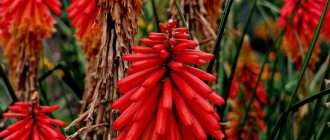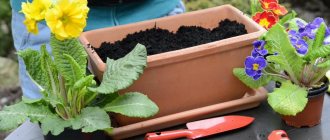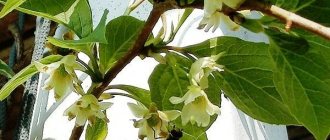Asian primroses in full bloom are sure to delight the heart at first sight in late spring. Primula bulleyana, P. beesiana, P. japonica, P. pulverulenta; These are all plants of great beauty and color. The genus Primula includes more than 450 species.
Among the most beautiful and colorful is Primula denticulata, an easy growing plant native to the meadows and light forests of the Himalayas. Primrose of this variety grows most in gardens. It is suitable for any garden where the soil is neutral or acidic and does not dry out in summer.
Primrose fine-toothed has distinctive large spherical heads consisting of many neat bell-shaped densely packed golden flowers, 25-30 cm high. The flowers are pink, lilac or red, and the leaves are finely toothed, slightly hairy and leafy, falling in the fall.
Flower buds begin to appear in the center of the expanding new leaves. These buds open before the flower stalks begin to elongate. The stems elongate over several weeks, bearing flower clusters to the top.
Its spoon-shaped leaves are silvery-green in color and mealy. The leaves initially begin to expand as soon as they appear.
In nurseries and garden centers you may find the plant simply called Primula denticulata, but there are many named garden forms that have clear reddish-purple and white flowers. There are also other types.
Hybrid varieties not only come in an array of colors, they can have single or double flowers. Primula vulgaris and Primula vulgaris sibthorpii have received the Royal Horticultural Society's Award of Garden Merit!
A truly worthy reward for a worthy plant. Primrose finetooth is unique in appearance and can be grown in a large, showy group. It is also good at home.
It can be grown under tall, leafy shrubs or near borders, but will also look good when sown in a bog garden near water. Best companions include spring snowflake, Leucojum aestivum, tree anemone, Anemone nemerosa, and purple-pink dogtooth, Erythronium revolutum.
Description of the variety
Despite the wide variety of varieties, primroses have certain characteristics that unite its various variations:
- size - height from 15 to 30 cm, diameter 50–60 cm;
- family - primroses;
- leaves - at the beginning of growth they are not large 5-6 cm, by the end of the season they reach 30-35 cm, light green in color;
- stem - compact, straight;
- flower - forms inflorescences in the form of a ball, reaching 10–12 cm at the beginning of flowering and 40–50 cm at the end of summer, the size of one flower is from 1 to 3 cm, shades can be white, lilac, lilac, violet, ruby and blue;
- life time - from 3 to 4 years;
- flowering - from mid-April to early July;
- soil - moist, slightly acidic, light;
- Insolation of the area is partial shade; it may die under the sun.
This plant has several particularly common species that are worth considering in more detail.
Fine-toothed primrose is one of the species that has varieties with the following characteristics:
Pon-pon:
- size - height from 25 to 30 cm;
- leaves are wrinkled, large, reaching 30 cm by the end of the season, light green in color;
- stem - compact, straight;
- flower - forms inflorescences in the form of a ball of a standard size for primroses, the size of one flower is from 1 to 3 cm, shades can be white, dark blue, scarlet;
- life time - from 3 to 4 years;
- flowering - from mid-April to early July;
- the soil and insolation of the site are characteristic of primroses.
Primula Rubin:
- size - height from 25 to 30 cm;
- leaves are large, oval, oblong, finely toothed with wrinkles, reaching 25–30 cm by the end of the season, pale green in color;
- stem - compact, straight;
- flower - forms inflorescences in the form of a ball of a standard size for primroses, the size of one flower is from 6 to 10 cm, all shades of red, often ruby color;
- life time - from 3 to 4 years;
- flowering - from mid-April to early June;
- the soil and insolation of the site are characteristic of primroses.
The type of ear primrose is determined by the following parameters:
- size - height from 25 to 30 cm;
- leaves are small, dense, leathery, reaching 30–40 cm by the end of the season, gray-green in color;
- stem - compact, straight;
- flower - forms inflorescences in the form of a ball of a standard size for primroses, the size of one flower is from 3 to 5 cm, shades can be violet-brick and violet-blue;
- the peculiarity of the species is two-color flowers with a pale yellow circle in the middle;
- life time - from 3 to 4 years;
- flowering - from mid-April to early July;
- the soil and insolation of the site are characteristic of primroses.
Features of the species and popular varieties
There are many varieties of fine-toothed primrose that can be listed, but we will note the most common of them in our gardens. All of them have small flowers, collected in large heads on high stems-peduncles, and a wide rosette of elongated, jagged, pubescent leaves, which are very decorative in themselves.
Alba
Many plant species have cultivars called "Alba". This was not the case in our case either. The small flowers of this variety, up to 1.5 centimeters in diameter, are collected in ten-centimeter round dense caps of white color on peduncles ranging in height from twenty, at the beginning of flowering, to fifty centimeters in height. The variety is frost-resistant, prefers partial shade and moist soil.
Primrose fine-toothed variety Alba
Violet
As you can easily guess from the name, the primrose flowers of this variety are purple in color. The balls are slightly smaller and denser than those of Alba, and are located on stems up to twenty-five centimeters high.
Violet primrose caps Violet
Rubra
The fine-toothed primrose variety Rubra has a bright red, ruby hue. The height and shape of the cap is similar to the Violet discussed above. Winter hardiness, application and flowering time, like other primroses.
Rubra variety - dark ruby charm
Growing fine-toothed primrose from seeds
This plant reproduces in two ways:
- vegetative;
- sowing
In order to grow a new flower by dividing an adult plant, you need to have a front garden with these primroses in your garden. The sowing method is simpler. You just need to go to a specialized store and buy seeds and plant them in the garden.
Did you know? According to British legends, forest spirits live in this flower - creatures with wings that look like butterflies. They spend the whole summer there, decorating the primroses with drops of dew.
Sowing in the garden in the fall
Fine-toothed primrose should be sown at a shallow depth of 0.8 to 1.2 cm.
This is done as follows:
- You need to prepare a hole in the ground.
- Place the seeds in it at a distance of 0.5 cm.
- Cover the seed with a layer of 1-2 cm of fertile soil.
- Mulch with fallen leaves in a layer of no more than 5 cm.
In spring, only those seeds that have undergone natural stratification germinate. The main thing is that the autumn rains do not wash away the material from the beds. Primroses grown in this way should be replanted a year after sowing.
Important! If you sow seeds not in a garden bed, but in seedling boxes, then you should remember that the seed of this plant can only germinate in the dark.
Growing through seedlings
If this primrose is in one place for 3-4 years, then it becomes depleted and the flowers begin to become smaller. In order not to lose the planted plant, you need to divide the primrose vegetatively and transfer it to a new place . Dividing work should be carried out in mid-summer; after August 10–15, it is no longer worth doing it.
In order to propagate a plant vegetatively, you need to:
- Water the flower well.
- After the water is absorbed into the soil, dig up the plant.
- Wash the roots with water and divide them into several parts with a sharp tool.
- Treat the cut areas with wood ash.
- Replant the separated parts into a new bed.
When planting seedlings, several rules should be followed:
- There should be a distance of about 25–30 cm between the primroses in the flowerbed.
- The area on which the flowers will grow should be well moistened and in slight shade.
- The soil needs to be light, since in very loamy soil the flower may die.
- After planting the primrose, you need to mulch the soil to a depth of 5–7 cm with leaves or grass.
Important! In order for the primrose to take root normally and grow well in the future, the soil next to it must be constantly moist.
Flower propagation methods
You can grow primrose from seeds, by dividing the bush and by leaf cuttings.
Cuttings
Shrub rose in a pot - can it be grown at home?
To successfully propagate a plant from cuttings, leaf rosettes with a small part of the rhizome are harvested from May to June and planted in a shaded place. Over the summer, the cuttings take root, overwinter, and in the spring they are planted in a permanent place of growth.
Dividing the bush
The procedure for dividing the mother plant is carried out at 3-5 years of life after the flower has fully grown. The time for dividing the bush is chosen in early spring or summer. To do this, dig up the primrose, carefully shake off the soil and use a sharp knife to separate it into parts, leaving at least one rosette in each. The sections are treated with ash. The separated parts are immediately planted and watered daily for 2 weeks.
Seeds
Growing fine-toothed primrose from seeds is carried out in two ways:
- Sowing in the garden in the fall.
- Growing through seedlings.
The first method is to sow in loose soil to a depth of no more than 1 cm. The seeds are laid out on the surface of the soil and sprinkled with substrate. You can sow in ordinary seedling boxes and bury them in the garden.
Important! Darkness is necessary for germination of fine-toothed primrose seeds; this should be remembered when sowing.
Seeds sown in the fall will undergo natural stratification and sprout in the spring. It is necessary to ensure that fragile plants are not washed away by spring waters. In the fall, grown primroses are transplanted to a permanent place.
Growing through seedlings requires more attention. You need to start working at the end of January, combining seed germination with artificial stratification:
- To begin, the seeds are laid out on a cotton pad using a dampened match or toothpick, covered with a second disc, and placed in a small container. The discs are slightly moistened.
- The container with seeds is alternately kept in the refrigerator and at room temperature, gradually increasing the time the seeds remain in the room.
- After the seeds hatch, they are planted in the ground. During the growing of seedlings, 2 picks are carried out.
- Plants are planted in a seedling bed at the end of May, and planted in a permanent place of growth in the fall or spring of the next year after flowering (until mid-August, so that the plant has time to take root and prepare for winter).
Primrose seedlings
It is important to know! Sowing is carried out from the seeds of the current year, this increases the chances of a positive result when growing the plant.
At all stages of growth, it is worth protecting the plant from direct sunlight. An excellent place for propagating primrose in open ground would be an area under a tall, spreading tree. The young plant will not bloom immediately, but only in the 3rd year or 2nd year.
Home care
If the fine-toothed primrose grows not in the garden, but at home in a pot, then it needs some care. The main thing is to comply with the following requirements:
- temperature regime;
- watering;
- lighting.
In addition, the plant should be in a pot with soil that suits it best. At the same time, the crop needs to be fed. Fertilize primrose 2 times . Immediately after transplantation - organic fertilizing: bone meal, compost or peat, and in the fall - ammonium nitrate.
Video: Spring care for fine-toothed primrose
Priming
For primroses, light, fertile soil is preferable . You can independently prepare a soil mixture from equal parts of peat and leaf soil and sand.
Soil with a high clay content is not suitable, because the plant may die . Such soil requires drainage from perlite or vermiculite, laid on the bottom of the pot in a layer of up to three centimeters.
Find out also about the varieties of primrose Ballerina.
Lighting
You need to choose a place in the house where you can provide the flower with diffused light. But this is ideal, and any area in an apartment with partial shade can be suitable, the main thing is that the primrose should not be exposed to direct sunlight . In this case, the primrose will delight with flowering from February to July.
Temperature
In order for the primrose to bloom for a long time, it should be kept in a place that is neither hot nor cold. The ideal temperature for a flower is from +8°C to +16°C.
Humidity
The plant loves moisture . If there is not enough air humidity, the leaves may dry out and the flowering period will be shortened. In such cases, it is recommended to spray the leaves and stems of the plant daily. At home, the flower needs to be watered with 2-3 liters of water once a week . If the summer is hot and it is not possible to keep the apartment cool, then watering should be increased to twice a week.
Did you know? According to German legend, one of the apostles dropped the keys that opened the gates to heaven to the ground. Having touched the surface, they turned into primroses.
Sowing primrose seeds immediately after collection and winter sowing
sowing primrose
Primrose is easy to grow. The seeds (primrose seeds) require some cold processing, which requires some knowledge, although this simply means that the seeds need to spend some time in the refrigerator.
Most primroses are hardy plants and actually need the cold. Primula denticulata is easy to grow, prefers moist soil and good watering, and because it is native to western China, Nepal and Tibet, it tolerates cold very well. It appears early and is frost resistant.
Primrose prefers to grow in snowmelt areas and will still grow well for a few years and then die. You can plant in late winter each year, so by September you will have plenty of mature seedlings to replace. The trick is to never allow the seedlings to dry out and grow in slightly shaded conditions in pots during the summer.
Pests or diseases rarely bother primroses. Some gardeners report problems with spider mites during hot, dry weather. Slugs can damage leaves during wet summers.
Broken foliage can be removed and the plants will continue to grow in the fall. The easiest primroses to grow from seed include the garden polyantha hybrids, P. vulgaris, P. veris, P. elatior, and several species of primrose, including P. japonica. Select species that are suitable for the climate and that are easy to grow from seed.
Seeds can be sown any time from January to the end of March. It is important to grow primrose correctly. Fill small pans with a wet starting mix such as Pro-Mix (This liquid concentrate provides your plants with the nutrients they need to help them thrive).
Then sow the seeds sparsely and cover them with a thin layer of vermiculite. Plants even need to be kept in cold temperatures from -2 to -8 degrees. Place the pots outside, exposed to the weather, but on the north side of the building or under bushes for protection from wind and winter sun.
Cover the pots with old plastic or a glass dome to protect them from precipitation. The seeds will germinate in March or April, depending on when they were sown. You need to control the temperature for germination and monitor the weather.
To soak the seedlings as soon as they sprout, place the pots in a shallow pan and fill the pan with a few inches of water. When the surface of the soil in the pots is damp, remove them from the pot and let them drain. Never let the seedlings dry out. When the seedlings have true leaves, transplant them into containers filled with flooded soil.
Remove all soil from the pot, gently push the roots apart and place individual seedlings 3cm deep into a container with prepared soil. Later, install small plants in small containers and finally move them into the garden in early fall.
Use mulch with chopped leaves and water from young plants. When the ground freezes, cover the primroses with evergreen branches to shade them and keep the ground frozen. They will bloom modestly next spring and profusely next year!
Growing from seeds
In order to grow primrose from seeds, you should follow a number of simple steps:
- The seeds must be placed on a cotton pad located in the container.
- They should be covered with a second disc on top and slightly wet.
- The container should initially be kept in a cool place +10°C or +15°C, then transferred to a warmer place, increasing the temperature to +18°C.
- When the seed begins to germinate, it must be transplanted into a seedling box.
Dividing the bush
Dividing the serrated primrose should be done one way or another every 3-4 years, as the plant ages and weakens . Primrose is divided into several parts and transferred to a new place or container without any problems. This operation can be carried out even when the plant is blooming.
Find out more about how to propagate primrose.
Primrose serrata - indoor varieties, appearance
Currently, more than 500 varieties of the plant are known. In addition to one of the most common types of primrose fine-toothed pon-pon, there are several other varieties that are used by gardeners.
Alba
One of the most common varieties. It is quite easy to grow. Blooming flowers grow up to 15 mm and are distinguished by a white tint, and the inflorescences that form from them can reach 100 mm in diameter and 500 mm in height.
Interesting! This species is quite frost-resistant and likes to grow in partial shade and moist soil.
Alba
Red
The red serrated primrose is a rather unusual primrose. She loves to grow in shaded areas of the garden. At the same time, the bush requires quite a lot of moisture. It is not recommended to use clay soil for planting it at home.
The bush has increased frost resistance - it is able to grow at temperatures down to -24 ° C. Blooming flowers can be white, purple, or lilac.
Violet
This variety attracts attention with its dense spherical inflorescences of a purple hue. Violet begins to bloom in April and ends towards the end of June
This perennial is characterized by the presence of large, finely toothed, wrinkled leaves.
Interesting! Most often, purple primroses are used to create rock gardens, green borders and landscaping.
Violet
Ruby
This variety exactly lives up to its name - the blooming flowers have a color similar to the natural shade of ruby. It has elongated dark green foliage. The buds form spherical inflorescences with a diameter of up to 60 mm. This variety is widely used to decorate borders or artificial ponds.
Interesting information! Ruby blooms quite early - from mid-May to late April.
Ruby
Bugle beads
This low-growing variety rarely reaches a height of more than 300 mm. Unlike its relatives, bugles have quite powerful foliage. Blooming flowers can have different shades - blue, purple, white, pink. The buds, like those of other primroses, form spherical inflorescences growing on strong peduncles 10-15 cm high.
Bugle beads
Diseases and pests
The plant is susceptible to the following diseases:
- Rot. On the flower, the leaves become covered with gray or watery spots, then the root and stem are affected. The disease can lead to the death of the plant. At the initial stages, the affected areas are treated with Ridomil Gold or Alyet. In advanced forms, if more than 30% of the primrose is affected, the flower is destroyed.
- spotting. Yellow-brown spots form on the plant, around which a transparent coating appears. The diseased flower turns black and dies. Control measures are fungicidal drugs (“Fitosporin-M”, “Alirin-B”).
- Nematode. Curves shoots and root system. The branches become weak, swellings appear on the roots. The disease cannot be cured; the flower must be destroyed.
Harmful insects that love primroses:
- spider mites;
- thrips;
- aphid;
- weevils.
When pests appear on a flower, it should be treated with insecticides (Aktara, Ampligo or Confidor).
Caring for primrose is not difficult, and even a beginner in the field of growing plants can reproduce and divide it. This bright primrose will take its rightful place in any flower collection.
How to determine the date of sowing primrose
For normal development, plants need at least 10–12 hours of daylight. Under natural conditions, without lighting, after winter it becomes like this at the end of February and remains favorable until autumn. In addition, it should be taken into account that primrose seedlings appear on the 20–30th day after sowing. Plus, almost all types require stratification:
- Primroses auricular, fine-toothed, polyanthus, giant, pink, when propagated by seed, require stratification lasting from 2-3 weeks to 2-3 months. Check the packaging of your seeds for more details.
- Primrose Julia, ordinary, tall, germinate without stratification. They can be sown in the garden before winter, as well as in the spring for seedlings, in May-April, but even for them, it is sometimes recommended to pre-stratify them on seed packets for 7–10 days to 3–4 weeks.
The need for stratification even for ordinary species is explained by the fact that primrose seeds quickly lose their viability during storage. Ideally, they should be sown immediately after harvest or stored in the refrigerator. The longer seeds are kept warm, the more difficult it is to awaken them, and stratification facilitates this process.
Landing rules
Transplanting and planting in the ground in the fall gives 100% survival rate if rooted rosettes with a developed root system are used. For a positive result, you need high-quality soil, a good location and compliance with planting rules.
- Selecting a location
Open lawns in the sun are not suitable for primroses. Primrose leaves wither if the plant is in the sun for more than 3-4 hours - in July the bush will be half dry.
The soil should be loose and nutritious. Add humus, sand, and peat to poor soil. To avoid fertilizing, add nitroammophoska, potassium, superphosphate - 3:2:1 tsp. per 1 m²
- Dividing the bush
Three to four year old plants with at least 5–7 rosettes are used. How to drop off:
- 1–2 hours before, water thoroughly;
- without damaging the roots, dig up the mother plant;
- kneading the lump with your hands, free the roots from the ground;
- separate the rosettes - the intertwined roots of the rosettes can be easily pulled out by gently pulling;
- plant the plant in the prepared hole without deepening the center;
- water generously.
The most common method of propagation is by dividing the bush.
You cannot leave exposed roots for a long time. For transportation, wrap them in wet cloth/newspaper and place them in plastic.
- Transfer
The roots of the bush are collected in a dense lump and go 10–20 cm into the ground. Therefore, for transplantation you will need a shovel:
- dig up the plant in a circle, deepening the shovel to a full bayonet - you should get a large lump from which almost no roots can be seen;
- add nutrient soil to the prepared hole;
- plant the plant - the root collar does not go deep and does not remain raised - the roots will be exposed;
- Water well.
In the video you can see how to transplant primrose bushes:
When to plant primrose seeds for seedlings
The timing of sowing primrose seedlings may vary for different plant varieties. Therefore, pay attention to the information on the packaging; it indicates the optimal time for a particular variety. As a rule, seeds are planted in January, February, March.
But first of all, you need to pay attention to the weather and climatic features of the regions in which cultivation is planned:
- In the South, you can sow in January or early February;
- In the middle zone (including the Moscow region) - in mid-February;
- In Siberia, the Urals, and the Leningrad region, it is better to plant in March.
When deciding when it is best to plant primrose seedlings, many gardeners and flower growers successfully resort to the lunar calendar. It helps you choose not only the most optimal days, but also the unsuitable ones. This plant is a perennial crop, but can be grown as an annual, so you need to take this feature into account. According to the 2022 Lunar Calendar, it is better to sow primrose seedlings as follows:
- Favorable days: in January: 1, 2, 10, 11, 15, 16, 19, 20, 27, 29;
- in February: 17, 18, 22, 23, 24;
- in March: 1, 3, 4, 20, 21, 29, 30;
- in April: 9, 10, 15, 16, 17.
- Unfavorable days: in January: 12, 21, 22, 28;
- in February: 11, 27;
- in March: 12, 28;
- in April: 11, 26.
Planting primrose in open ground
What is the best time to plant
So, when to plant primrose in open ground? It is recommended to do this in the spring or autumn, when she is two years old. If you choose spring for this procedure, then plan for the final days of the month of May.
Primrose on the site
A suitable place for planting perennial primrose will be one that is not directly exposed to the sun. It should be shaded by trees or bushes. Only alpine varieties need full sun when growing in northern areas. The soil should have a loose structure and light, absorb liquid well so that the water does not stagnate.
Clay soil will also be suitable. It can be heavy. To correct this situation, add a mixture: manure (2 kilograms), sand (one bucket), vermiculite and sphagnum. It is necessary to use this volume per square meter of land. Below we describe what planting and caring for primrose involves.
How to plant primrose
When primrose is planted in open ground, it is necessary to leave 0.2-0.3 meters between each one if it is large. In other cases - 0.1-0.15 meters. It is important to consider that this flower has a negative attitude towards open space. Therefore, when planning to plant seedlings, this should be done taking into account future growth. They must eventually touch each other.
Primrose in a pot
After about 2-3 years, flowers will appear.
Plant care
This plant appears on store shelves closer to spring. If primrose appears in the house, then it is necessary to take into account all the features of care. At home, you can make sure that the plant feels much calmer and better. To do this, you should take into account air humidity and watering.
Primrose should not be in a very warm room, and it should be watered quite rarely. You need to worry about the availability of liquid fertilizers, which should be used regularly during flowering.
Watch a video about caring for homemade primrose:
Features of garden care
It is necessary that the soil in the garden is fertile, because otherwise the plant will not take root. To be on the safe side, it is better to make a mixture of leaves and manure to fertilize the soil. Primrose should be watered no more than once a week, and be sure to use fertilizers with phosphorus.
This miracle of nature does not like direct sunlight, so during the day it is better to shade the area. For the winter period, the primrose must be prepared by covering it with straw or branches so that the plant does not freeze.
You will find more information about growing and caring for garden primroses in a separate article, but here we talked about the intricacies of cultivating a flower in the fall.
Watch a video about caring for primroses in the garden:
Transfer
It is necessary to plant the plant only in the spring, when the temperature reaches the desired level. Primrose should be planted in a container with soil and drainage, ensuring a temperature of 15 degrees.
As soon as the plant takes firm roots, you need to transplant it into the soil, trying not to water it often. The primrose must get used to the new place, so it is worth checking its condition in the fresh air often.
Reproduction
- The plant can be propagated using seeds, but this method is incredibly complicated. The fact is that it is very rarely possible to grow primrose from those seeds that ripen in boxes. The longer they stay there, the less germination they have.
- You can also use the method of dividing bushes. It is necessary to carefully dig up the plant and use a knife to separate part of the root. This should be done in spring or late summer. The separated parts of the root system are planted in prepared pots.
- There is a way to propagate primrose by leaf cuttings. It is necessary to carefully separate several leaves and roots and then place them in a mixture of river sand and soil. This method of reproduction will occur within 20 days.
The features of sowing primrose seeds at home and planting seedlings in open ground, as well as further care, are discussed in detail here.
Thanks to such a variety of primrose varieties, you can easily choose exactly what you will like and delight. You just need to choose the right approach for each species and then the plant will feel great and delight others.
In landscape design
Garden primrose, thanks to its wide variety of colors, allows you to create an amazing ornament on your site. Since flowering times vary greatly, you can choose varieties that, replacing each other, will delight you from April to August. Flowers are used to decorate ridges, alpine hills, flower beds in the shade of trees, border edging, shrubs, and the high bank of a reservoir. They look good next to muscari, tulips, daffodils, irises, phlox, and soapwort. Some species with inflorescences on long stems are cut to make bouquets.
Caring for Primrose Julia
Among primroses with spectacular flowering, it is difficult to find a species that is so undemanding in care. Julia Primroses require virtually no care and grow on their own, content with minimal care and making garden maintenance easy. The plant is divided only when desired; it does not lose its ability to bloom beautifully for decades.
Watering is carried out only for Julia primroses growing in the sun. Early spring fertilizing may not be necessary, but annual fertilizing helps to enhance flowering. Loosening the soil, weeding and mulching are also not necessary measures for adult plants, which are carried out only when there is a need to change the condition of the soil or when the compositions are neglected.
Primrose Julia belongs to the winter-hardy species. It is believed that they can withstand frosts down to -30°C; adult plants do not need protection for the winter in the middle zone. Only young one- and two-year-old plants are additionally protected by mulching. Such protection is a necessary condition when growing in ventilated areas.
Primula Julia is a very winter-hardy plant.Selection and preparation of containers
With the choice of landing container, everything is now very convenient and simple. In any store specializing in goods for the garden and garden, or a regular hypermarket, you can buy a variety of containers for planting. You can also use improvised means, for example, various bowls, cut plastic bottles, etc.
It is very convenient to plant primrose seeds in the following containers:
Since flower seedlings need picking, it is very convenient to initially sow the seeds in a common plastic or wooden box, and then plant them . But when growing in peat tablets, there is no need to pick seedlings.
Important! There must be drainage holes at the bottom of the planting container. If you did not find them when purchasing, then you need to make holes yourself. The exception is peat tablets and pots; there is no need to make holes in them!
Before planting seeds, it is recommended to disinfect containers (except peat tablets). Simply rinse the container with a solution of potassium permanganate or a fungicide solution.
Section of candelabra primroses
This group includes about 30 species. Such plants are distinguished by long peduncles that appear in the summer months. In order for the bushes to germinate quickly in the spring and delight you with their flowering as early as possible, they need to be covered with special agrofibre for the winter. You can see what the primroses from the candelabra section look like in the photo.
In the sun, primus flowers can lose their shade.
The most popular varieties of this group:
- Japanese primrose. The birthplace of this flower is Japan. It can also be found on the Kuril Islands. Compared to other varieties, Japanese primrose has a peduncle about 50 cm high. The buds are arranged in tiers. When loosened, they can acquire a crimson or snow-white hue. This primrose develops well on fertile soils in partial shade.
- Primrose powdered. This type is the most decorative among the candelabra section. In nature, the flower grows in the marshy areas of China. This species differs from others in the white coating that covers the entire peduncle. A small amount can also be observed on the leaves.
Also included in this section is Primrose bullea. This is a biennial, which, with proper care, can be a perennial. The flowers of this primrose are orange in color with a yellowish tint. All of them are collected in large inflorescences on a peduncle of about 50 cm. You can see the flowering from June to July.











